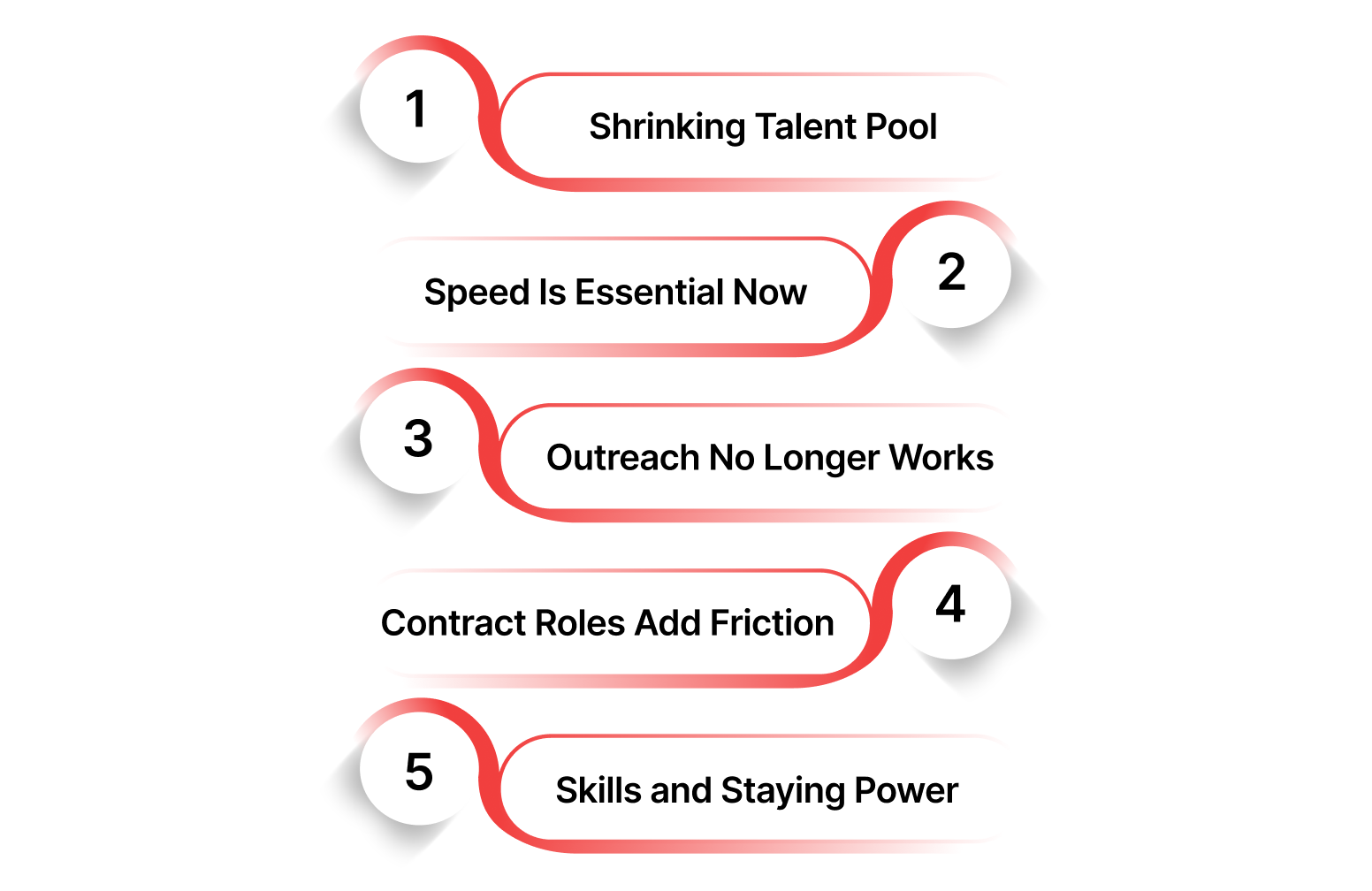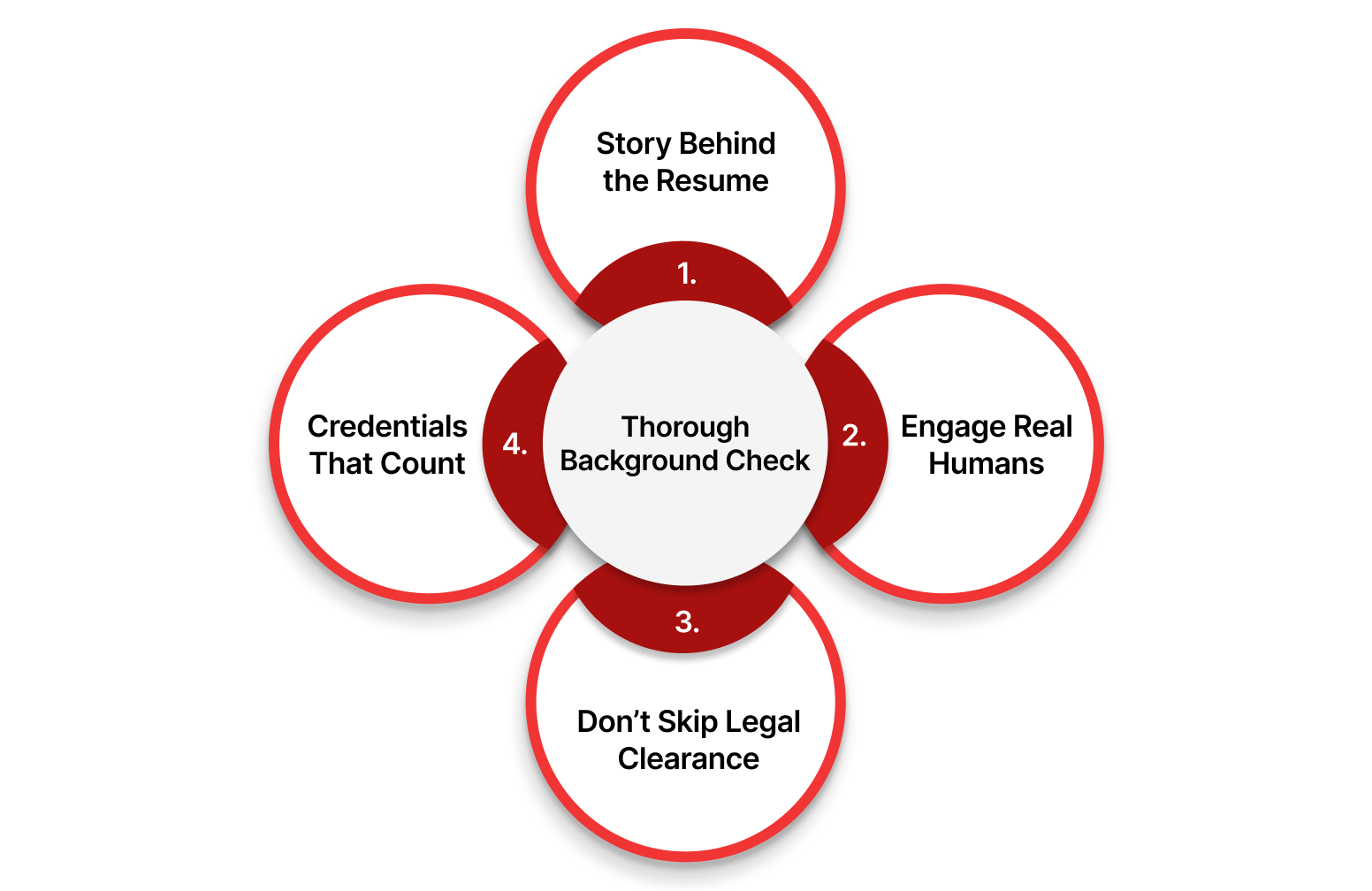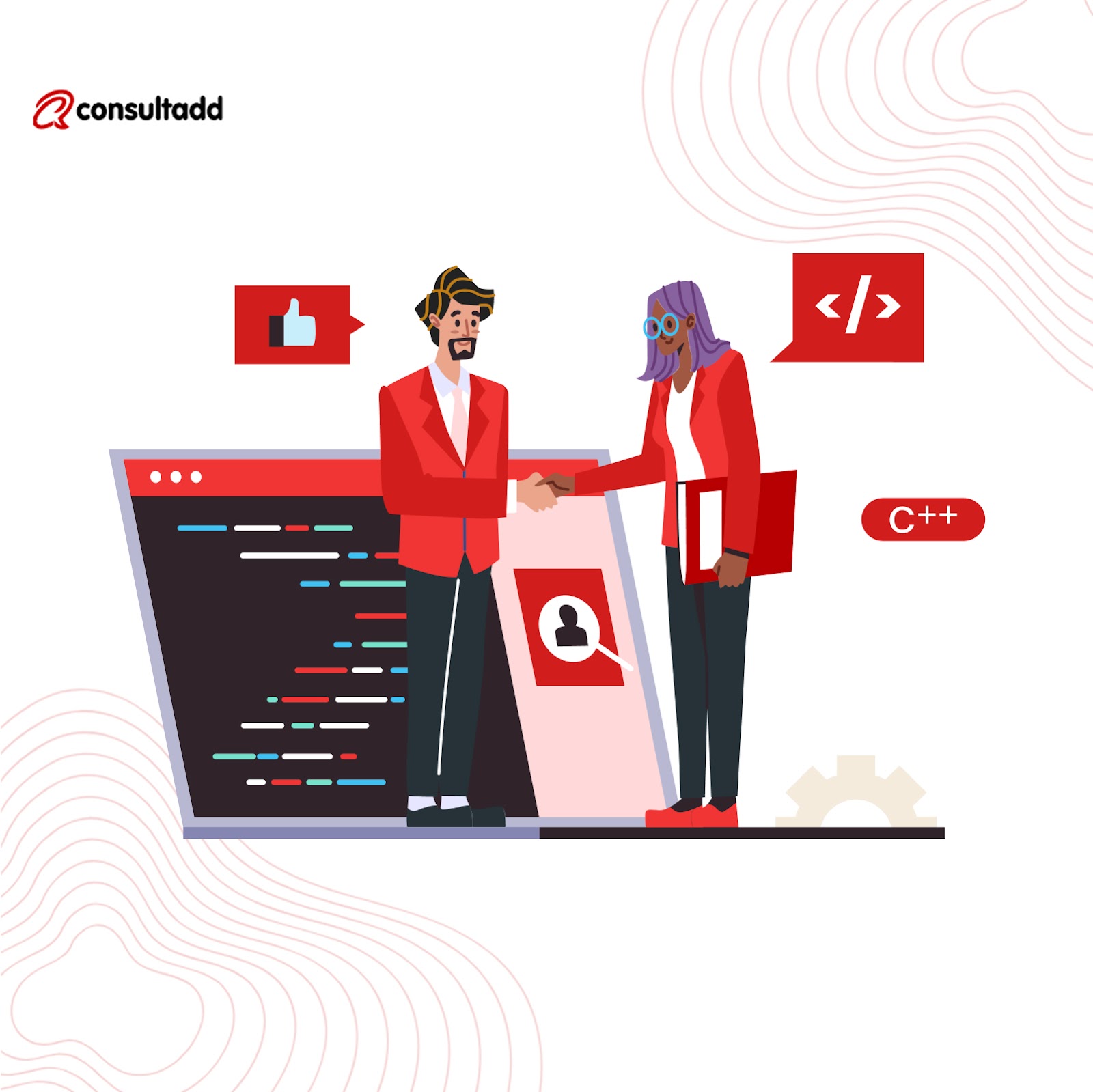It’s 2025, and you’re still facing the same challenge: finding software engineers who don’t ghost, flake, or disappear mid-process.
You’re not alone.
The demand for strong technical talent is rising fast, with software roles projected to grow 17% by 2033, adding over 327,000 new openings. That means more competition, fewer qualified candidates, and higher stakes for every hire.
But hiring today isn’t just about moving fast. It’s about making the right call. You need engineers who are technically excellent, culturally aligned, and able to contribute from day one.
To make that happen, your hiring strategy needs to evolve beyond job boards, basic filters, and reactive recruiting.
In this article, we’ll explore a smarter, more strategic approach to find only the best software engineers.
TL;DR
- Finding software engineers in 2025 requires speed, precision, and cultural fit amid fierce competition.
- Hiring success depends on clear roles, impact-driven descriptions, and proactive sourcing beyond job boards.
- Skills-based assessments and behavioral interviews ensure ability and team fit, reducing mis-hires and improving retention.
- Fast offers and structured onboarding build trust and strengthen long-term engineer commitment.
Why a Strategic Approach to Find Software Engineers in 2025?

Hiring today is no longer about who responds, it's about who’s still available when you do.
A quick post on a job board won’t cut it anymore. The best engineers are gone before they even hit “apply.” Here’s why you need a sharper, faster, and more strategic approach:
1. Talent Pool Is Shrinking
- Demand exceeds supply, especially for cloud, DevOps, and full-stack engineers.
- Top talent isn’t on job boards, they’re handpicked before roles are public.
2. Speed Is a Dealbreaker
- Hiring cycles are tightening. Delays mean losing out every time.
- Candidates expect fast, respectful communication. A well-run process builds trust and increases acceptance rates.
3. Generic Outreach Doesn’t Work Anymore
- Personalization matters. Relevance matters more.
- Your offer must speak to impact, not just job titles.
4. Contract Roles Come With Extra Friction
- Many candidates hesitate at the word “contract.”
- They fear instability, lack of growth, or visa complications.
Pro Tip: A strategic partner smooths these concerns with trust, clarity, and long-term support.
5. Need More Than Skills, Need Commitment
- Hiring isn’t just about coding, it’s about performance and fit.
- Engineers must collaborate, adapt, and align with business goals.
When hiring is reactive, you’re always one step behind. But with the right strategy, you're ready before the need even arises.
9 Steps to Hire the Best Software Engineers
Hiring engineers in 2025 means building fast, precise momentum with talent that stays.
Here’s how to do it right, from first step to final offer.
1. Define Your Hiring Needs
Before you post a role or contact a candidate, get crystal clear on what you’re hiring for.
This early clarity prevents mis-hires, reduces back-and-forth, and earns trust with clients and candidates alike.
Define early. Define clearly. And you won’t just fill roles, you’ll fill them with the right people.
Clear requirements are the foundation, but best-in-class hiring demands best-in-class execution. Check out How to Hire the Best: The Recruiting Best Practices You Need for a proven framework that drives precision and repeatable success.
2. Flip Your Job Description to Focus on Impact Over Requirements
If your job ads still say “5+ years experience,” you’re behind.
In 2025, great engineers want purpose, ownership, and growth, not checklists.
Why Traditional Job Descriptions Fall Flat
- They focus on history, not potential.
- Top candidates tune out when roles sound generic or outdated.
What High-Performers Want to See
- Impact: How their work moves the needle.
- Ownership: The autonomy they’ll have in decisions and execution.
- Growth: Whether the role challenges them and supports their career journey.
Pro Tip: Pitch the role, not just the requirements, highlight growth, ownership, and an inspiring team.
Remember you’re not writing a checklist, you’re writing a pitch to top-tier talent.
3. Source Top Talent Through Headhunting and Specialized Channels
Posting and praying isn’t a strategy, it’s a delay.
In 2025, sourcing top software engineers requires sharper tools and smarter channels.
- Actively headhunt on developer platforms
Scan sites like GitHub, Stack Overflow, Reddit, and Twitter for active contributors. - Use niche job communities and invite-only platforms
Tap into platforms like Hired, AngelList, and Wellfound to find high-intent candidates. - Utilize tech staffing partners when urgency is high
Need talent fast? Specialized partners offer screened, ready-to-join engineers. - Source globally with a remote-first mindset
Expand globally with async work, fair pay, and easy onboarding.
Smart sourcing is about finding the right engineers before they find someone else.
Struggling with slow hiring cycles or unqualified applicants?
Consultadd delivers pre-vetted, ready-to-deploy engineers, screened for skills, experience, and compliance. That means less time sourcing, fewer drop-offs, and faster placements with real staying power.
4. Prioritize Skills Over Resumes
A resume can look perfect on paper and still lead to a mis-hire.

Steve Jobs once said,
“Technology is nothing. What’s important is that you have faith in people, that they’re basically good and smart, and if you give them tools, they’ll do wonderful things with them.”
Therefore, hire for ability, not background. Some of Apple’s greatest innovations came from unconventional hires driven by curiosity and execution, not polished resumes.
In 2025, real ability matters more than job titles.
Why Resumes Mislead:
- Job titles do not reflect true capability
- Big-name companies do not guarantee hands-on skill
- Many candidates exaggerate but underperform
What to Do Instead:
- Use skills-based assessments tied to real work
- Shortlist based on what candidates can build, not just where they have worked
- Do not fixate on degrees. Many great engineers are self-taught
- Review side projects or GitHub profiles to validate skills
- Ask scenario-based questions early
In short, skill-first hiring reduces bias, improves fit, and builds better teams.
To truly embrace skills-first hiring, it’s crucial to understand which skills matter most in today’s market. Our blog Most Wanted Skills You Should Know in Skills-Based Hiring breaks down the high-demand capabilities you should prioritize in 2025.
5. Assess Technical Skills Through Relevant Tests
A smart test shows what candidates actually deliver.
For a deeper dive into building an effective, structured screening flow that uncovers top talent, read our blog How to Master the Tech Interview Screening Process.
6. Conduct Behavioral Interviews to Assess Team Fit
Hiring someone who can code is easy.
Hiring someone your team wants to code with? That’s where the real work begins.
Q: Why are behavioral interviews essential?
Technical skills don’t show communication, adaptability, or response to feedback.
Team fit can make or break project success, regardless of coding ability.
Q: What should you be listening for?
Ownership, emotional intelligence, and problem-solving under pressure.
You’re hiring for growth, grit, and collaboration.
Q: What are some effective questions to ask?
- “Tell me about a time you disagreed with a teammate. What happened next?”
- “When have you stepped outside your role to help a project succeed?”
- “How do you handle feedback when you strongly disagree?”
These reveal values, self-awareness, and how well they play in a team setting.
Q: Should the team get involved?
A 15-minute chat with future teammates reveals more than interviews.
It shows chemistry, communication, and team energy fit.
7. Perform a Thorough Background Check

Even the most impressive resume can hide deal-breaking red flags.
One weak hire can derail timelines and damage client trust.
1. Check the Story Behind the Resume
- Verify employment history and project scope, don’t rely on surface-level claims.
- Look for consistency, ownership, and real-world delivery.
2. Speak to Real Humans, Not Just LinkedIn
- Call former managers or tech leads, not just listed references.
- Ask about reliability, communication, and problem-solving under pressure.
3. Don’t Skip Legal Clearance
- Confirm visa status, non-competes, and eligibility to work.
- Avoid last-minute surprises that stall onboarding.
4. Dig Into Credentials That Matter
- Validate certifications only if they apply directly to the role.
- Focus more on skills tested, not logos earned.
Thorough background check protects your client, your candidate, and your reputation.
8. Onboard the Engineer with a Structured Plan
A strong onboarding experience builds early trust, accelerates productivity, and sets the tone for retention.
When onboarding is done right, engineers settle in faster and stick around longer.
9. Monitor Progress During the Probationary Period
The probation window isn’t just a formality, it’s your second chance to assess alignment and impact.
Make it count by keeping the process structured, focused, and supportive.
- Create weekly feedback loops
Don't wait till the end, offer bite-sized feedback along the way. - Check alignment with team culture
Observe collaboration, ownership, and willingness to learn. - Look beyond technical delivery
Track communication, proactivity, and ability to handle feedback. - Document observations consistently
Use a shared scorecard to avoid bias and stay objective. - Decide early, not late
If doubts persist after week six, start planning your next move.
Consistent check-ins help you catch red flags and give great hires the credit they deserve.
Scaling tech teams isn’t just about hiring, it’s about sustainability.
Consultadd takes care of the heavy lifting: visa support, onboarding, documentation, benefits, and payroll. You focus on growth while we handle the admin that slows teams down.
Conclusion: Hiring and Retaining the Best Software Engineers in 2025
Hiring in 2025 demands precision, speed, and trust. Recruiters face vanishing candidates, compliance delays, and poor retention. They need a strategy for long-term value.
That’s why every step from clear job definitions to onboarding must be backed by a partner who understands the real pressure of staffing.
Here’s how Consultadd empowers you to hire better and retain longer:
- Safe, reliable hires: Candidates thoroughly vetted for skill, compliance, and cultural fit.
- Lower turnover risk: No more early exits our talent is committed to long-term success.
- Compliance made easy: From visa checks to documentation, we handle the heavy lifting.
- Speed without shortcuts: Ready-to-deploy engineers, sourced in less than 24 hours.
- Dedicated support: 1:1 account managers guide you from req to ramp-up.
- Proven success:
- 5K+ successful staffing engagements
- ~65 staffing companies supported in the last year
- MSAs signed with Robert Half, Teksystems, and other industry leaders
- Top 100 high-performing candidates placed in the last 12 months
- Strong university connections to tap emerging talent
In a market where the right hire can make or break a deal, Consultadd ensures your placements are future-proof.
Ready to partner with a team that treats your hiring goals like their own?
Let’s build your winning tech team starting today.
FAQs
Q1: Why is speed critical in hiring software engineers in 2025?
Hiring cycles are tightening, and delays mean losing top candidates. Fast, clear communication and quick offers build trust and prevent candidates from accepting other opportunities.
Q2: How can companies better assess software engineers beyond resumes?
Focus on skills-based screening with real-world tests, scenario questions, and reviewing open-source projects. Behavioral interviews assess teamwork, communication, and cultural fit, ensuring a well-rounded evaluation.
Q3: What role does onboarding play in retaining new engineers?
Structured onboarding with clear plans, mentorship, and regular check-ins accelerates productivity, builds trust, and fosters a sense of belonging, which improves retention and long-term success.

